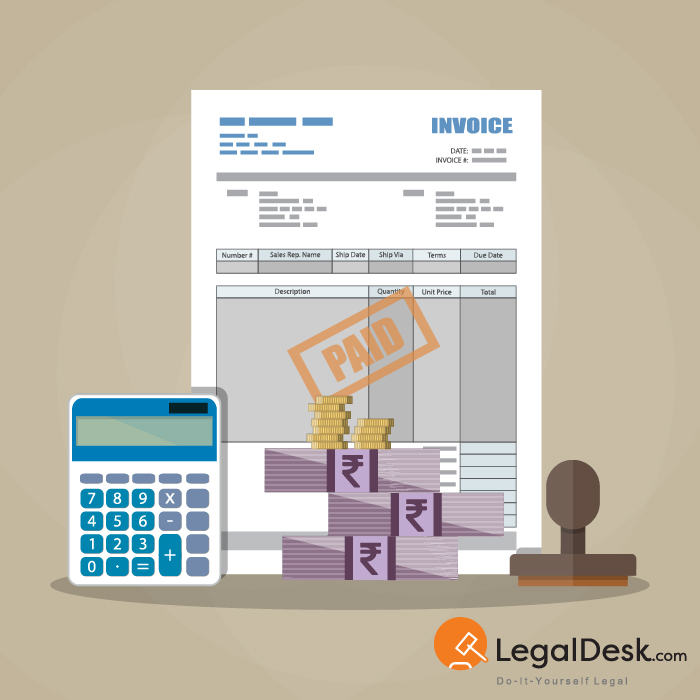An invoice forms a crucial function when it comes to execution of transaction. The invoice is a document sent to a buyer that specifies the amount and cost of products or services that have been provided by a seller. It contains details of the products or service and other information that varies depending on the requirements in the country the invoice is issued and the type of product or service being sold.
Through this article, we would like to share some knowledge about Invoicing in the current GST regime.
Different Types Of Invoices
The different type of Invoices in the previous tax regime vs the GST regime are as follows –
Current Tax Regime
Under the old tax regime, there were 3 types of invoices issued:
- Excise Invoice – Issued to highlight all the particulars of goods along with details of duty paid to let the recipient know how much tax has been charged and how much CENVAT credit one can claim on the purchase of the goods.
- VAT Invoice – Issued by registered VAT dealers in the manner as prescribed by the State VAT laws of the respective state of the supplier.
- Retail or Commercial Invoice – Issued to an unregistered dealer or retail customer. The VAT charged in the bill is shown separately but as it is issued to the ultimate consumer who has the final liability to pay the tax, tax credit is not to be passed on and hence tax credit can’t be claimed on this invoice.
GST Regime
Under the Goods and Service Tax regime, there are only 2 types of invoices issued:
- Tax Invoice – When a registered taxable person supplies taxable goods or services, a tax invoice is issued.
- Bill of Supply – In cases where a tax invoice cannot be issued, a Bill of Supply is issued. For ex., Composite Tax Payer
Cases where a registered supplier needs to issue a Bill of Supply:
- Supply of Exempted Goods or Services
- Supplier is paying tax under composition scheme.
Most Common Questions About Invoice, Debit Note And Credit Note
Q1. When should a Tax Invoice be issued for supply of Goods?
The answer to this depends on type of Goods:
- If the goods are such that movement of goods are involved, then taxable invoice has to be issued before or at the time of removal of the goods.
- If supply of goods does not require movement of goods, then taxable invoice has to be issued at the time the goods are delivered to the recipient or when the goods are made available to the recipient.
Q2. How can goods be supplied without movement?
There are many situations in which such a supply is possible. In such cases, the supplier should be giving up his control over the goods, even though the goods have not moved from the place in which they are.
Ex: When an Agent who is in possession of some goods decides to buy the goods on his account, there will be a delivery without any movement of the goods. These cases will also cover assembly and delivery of machinery on site by the supplier.
Q3. Do I have to issue an invoice even if I remove goods for ‘sale on approval basis’?
Yes, invoice has to be issued even if goods are removed for ‘sale on approval basis’ in terms of Section 28(8) of the Revised Model GST Law. According to Section 28, where the goods (being sent or taken on approval or sale or return or similar terms) are removed before it is known whether a supply will take place, the invoice shall be issued before or at the time when it becomes known that the supply has taken place or six months from the date of removal, whichever is earlier.
Q4. When to raise an invoice for providing services?
Invoice has to be raised within 30 days of providing the service. You might also be interested to know how to raise an Invoice under GST.
Q5. Can an unregistered person issue a tax invoice?
No, only a registered taxable person can issue tax invoice. Also, section 29 specifically prohibits collection of tax by a person who is not a registered taxable person.
Q6. Is it necessary for issuing invoice for advance?
Yes. A receipt voucher or any other document containing prescribed particulars should be issued on receipt of any advance payment towards supply of goods.
Q7. When can a Credit Note be issued?
For issuing a Credit note, an invoice for a supply should have been issued earlier and subsequently the following situations should arise,
- The taxable value on which the tax is collected is more than the actual taxable value
- The tax charged is more than what you should have charged
- The recipient has returned the goods
- The recipient has found that the services supplied by you are deficient
Q8. Will my tax liability be reduced if I issue a Credit Note?
Normally, tax liability should reduce if a Credit Note is issued. However, there are certain procedural requirements before that can happen. These requirements are:
(a) The incidence of tax and interest on such supply should not have been passed on to any person other than the recipient to whom the credit note is issued. It may be noted that under section 44(9), it is deemed to have passed the full incidence of tax to the recipient of the goods/services.
(b) The recipient of the supply should accept the credit note in his return of inward supply and reduce his claim of input tax credit at least to the extent of reduction of tax liability.
Q9. When I reject an inward supply, can I issue a Debit Note?
For accounting purposes, you may do so. But, for the purpose of GST, such a debit note will be of no consequence. There is no concept of issue of debit note by the recipient of supplies. Under the scheme of things, both debit note and credit note are issued by the supplier only.
Q10. Does that mean that the Debit note can be issued only for increasing the tax liability by the supplier?
Yes. ‘Debit notes’ are akin to ‘supplementary invoices’. They are issued by the supplier for recording increase in taxable value or tax charged in the supply.
Q11. What should the contents of a tax invoice be?
Normally, the tax invoice should have the following details:
(a) Name, address, GSTIN of the supplier
(b) Serial Number having only alphabets / numerals
(c) Date of Issue
(d) Name, and address of the recipient
(e) GSTIN/UID of the recipient, if registered
(f) HSN code for Goods or Accounting Code for Services
(g) Description of Goods / Services
(h) Quantity and Unit (or Unique Quantity Code) in case of Goods
(i) Total Value of Goods and Services
(j) Post discount/abatement taxable value of Goods and Services
(k) Rate of Tax, Separately for CGST & SGST or IGST
(l) Amount of Tax Charged
(m) Place of Supply along with the name of the State if the supply is not intra-State supply
(n) Place of delivery if different from place of supply
(o) Whether tax is payable on reverse charge
(p) Signature/Digital Signature of the Supplier or his authorised representative.
Q12. What are the contents of a ‘Bill of Supply’?
A Bill of Supply should have the following details:
(a) Name, address, GSTIN of the supplier
(b) Serial Number having only alphabets/numerals
(c) Date of Issue
(d) Name, and address of the recipient
(e) GSTIN/UID of the recipient, if registered
(f) HSN code for Goods or Accounting Code for Services
(g) Description of Goods / Services
(h) Post discount/abatement value of Goods and Services
(i) Signature/Digital Signature of the Supplier or his authorised representative.
Q13. What are the contents of Credit Notes, Debit Notes and Supplementary Tax Invoices?
These documents shall contain the following details:
(a) Name, address, GSTIN of the supplier
(b) Nature of the Document
(c) Serial Number having only alphabets/numerals
(d) Date of Issue
(e) Name, and address of the recipient
(f) GSTIN/UID of the recipient, if registered
(g) Name and address of the recipient and address of delivery, along with the name of state and its code, if such recipient is unregistered
(h) Serial number and date of the corresponding tax invoice/bill of supply
(i) Taxable value of goods or services, rate of tax and the amount of tax credited/debited to the recipient
(j) Signature/Digital Signature of the Suppler or his authorised representative.
Q14. How many copies of an invoice are required for supply of Goods?
The invoice should be prepared in triplicate. The original is for the recipient, triplicate for the supplier and the duplicate for the transporter. Duplicate copy is not required if an Invoice Reference Number is obtained. The copies should be marked as ‘ORIGINAL FOR RECIPIENT’, ‘DUPLICATE FOR TRANSPORTER’ and ‘TRIPLICATE FOR SUPPLIER’.
Q15. Can I raise an invoice to an unregistered person without any restrictions?
In terms of Rule 1 of Draft Invoice Rules, a tax invoice issued by the supplier to unregistered person as recipient must mention the name, address of the recipient and the address of delivery, along with the name of State and its code, if the taxable value of supply is Rs 50,000 or more. Hence, an invoice to an unregistered person can be raised with aforesaid restrictions.


